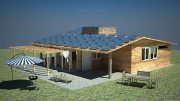Starting with nothing but a concrete slab, about 30 students, most of whom had never even picked up a saw before, designed and built a solar log house on the WVU campus. Now, they have torn it down, packed it up and headed to California for the Department of Energy’s Solar Decathlon competition. – See more at: http://www.youtube.com/watch?feature=player_embedded&v=7UA3zZtLGYs
Normally, you don’t build a house just to tear it down.
But that’s in the blueprint for an interdisciplinary team of West Virginia University students ready to embark on a one-of-a-kind journey to the West Coast.
Starting with nothing but a concrete slab, about 30 students – most of whom had never even picked up a saw before – designed and built a solar log house over the summer on the Evansdale campus.
They’ve now disassembled their creation – board by board – for transport via four truckloads to Irvine, Calif., where students will compete with 19 other collegiate teams from around the world in the 2013 Solar Decathlon, a design-and-build contest sponsored by the U.S. Department of Energy. The competition is slated for Oct. 3-13.
The WVU team received a $100,000 grant from the Department of Energy for the competition, but had to raise additional money and in-kind donations, including $50,000 for the cross-country trip.
WVU’s house is the first log-style home accepted into the Decathlon. It relies on natural resources to control temperature and incorporates a smart home system that utilizes sensors for various features.
The WVU team consists of about 50 students across multiple disciplines, which include the Benjamin M. Statler College of Engineering and Mineral Resources, the College of Creative Arts, the Davis College of Agriculture, Natural Resources and Design, the Perley Isaac Reed School of Journalism and the College of Business & Economics.
The winner of the competition is the team that best blends affordability, consumer appeal and design excellence with optimal energy production and maximum efficiency, reflecting rankings in 10 separate areas: architecture; market appeal; engineering; communications; affordability; comfort zone; hot water; appliances; home entertainment; and energy balance.
